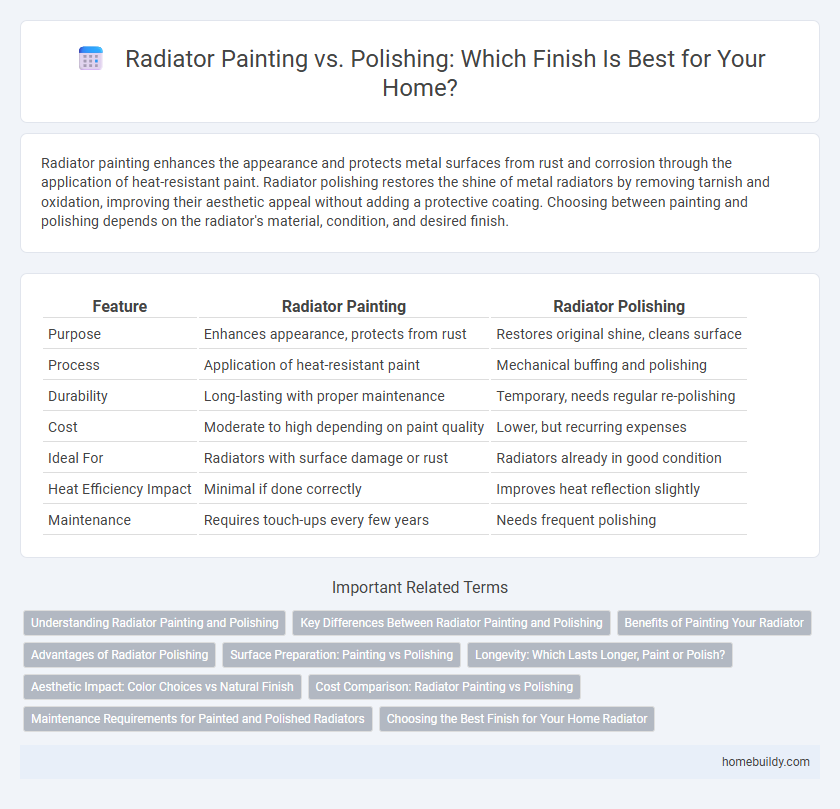Radiator painting enhances the appearance and protects metal surfaces from rust and corrosion through the application of heat-resistant paint. Radiator polishing restores the shine of metal radiators by removing tarnish and oxidation, improving their aesthetic appeal without adding a protective coating. Choosing between painting and polishing depends on the radiator's material, condition, and desired finish.
Table of Comparison
| Feature | Radiator Painting | Radiator Polishing |
|---|---|---|
| Purpose | Enhances appearance, protects from rust | Restores original shine, cleans surface |
| Process | Application of heat-resistant paint | Mechanical buffing and polishing |
| Durability | Long-lasting with proper maintenance | Temporary, needs regular re-polishing |
| Cost | Moderate to high depending on paint quality | Lower, but recurring expenses |
| Ideal For | Radiators with surface damage or rust | Radiators already in good condition |
| Heat Efficiency Impact | Minimal if done correctly | Improves heat reflection slightly |
| Maintenance | Requires touch-ups every few years | Needs frequent polishing |
Understanding Radiator Painting and Polishing
Radiator painting involves applying a specialized heat-resistant paint to protect the metal surface from rust and corrosion while enhancing aesthetic appeal. Radiator polishing, on the other hand, focuses on restoring the radiator's original shine by mechanically buffing the metal, which improves surface smoothness but does not offer protective coating. Understanding the differences helps in choosing between aesthetic enhancement through polishing or long-term protection with painting for cast iron or steel radiators.
Key Differences Between Radiator Painting and Polishing
Radiator painting involves applying a heat-resistant coat that protects against rust and enhances aesthetic appeal, while radiator polishing restores the metal's natural shine by removing tarnish and oxidation without adding any protective layer. Painting offers a customizable color finish that can match interior decor, whereas polishing maintains the radiator's original metallic look but requires regular upkeep to prevent dullness. The choice depends on whether durability and color variety or maintaining a classic, reflective appearance is the priority.
Benefits of Painting Your Radiator
Painting your radiator enhances corrosion resistance, prolonging the lifespan of the metal surface by creating a protective barrier against moisture and rust. It improves heat efficiency by allowing better heat transfer through specialized heat-conductive paints, leading to reduced energy consumption. Aesthetically, radiator painting offers customizable color options that seamlessly integrate with interior design, maintaining a fresh and modern appearance.
Advantages of Radiator Polishing
Radiator polishing enhances heat efficiency by removing corrosion and buildup, allowing for improved thermal conductivity and energy savings. It also provides a sleek, reflective finish that reduces the need for frequent repainting and maintenance, preserving the radiator's aesthetics longer. Polishing is a more environmentally friendly option since it minimizes the use of chemical paints and reduces waste from paint stripping and repainting processes.
Surface Preparation: Painting vs Polishing
Radiator painting requires thorough surface preparation, including cleaning, sanding, and applying a primer to ensure proper paint adhesion and prevent rust formation. In contrast, radiator polishing focuses on meticulous cleaning and buffing to enhance the metal's natural shine without altering the surface coating. Proper surface preparation for each method directly impacts durability and aesthetic quality of the radiator finish.
Longevity: Which Lasts Longer, Paint or Polish?
Radiator painting provides a durable protective layer that prevents rust and corrosion, extending the radiator's lifespan significantly when high-quality, heat-resistant paints are used. Radiator polishing, while maintaining a shiny appearance and removing surface oxidation, offers minimal protection against future wear and environmental damage. Consequently, painted radiators generally last longer than polished ones, especially in environments prone to moisture and heat fluctuations.
Aesthetic Impact: Color Choices vs Natural Finish
Radiator painting offers a wide range of color choices, allowing homeowners to customize their radiator to match interior decor and create a bold or subtle aesthetic impact. Radiator polishing emphasizes preserving the natural metallic finish, highlighting the radiator's original texture and reflective qualities for a timeless, elegant look. While painting introduces versatility through pigments, polishing enhances aesthetic appeal through material authenticity and shine.
Cost Comparison: Radiator Painting vs Polishing
Radiator painting generally costs between $50 and $150, offering an affordable way to refresh the appearance and protect against rust, while radiator polishing can range from $100 to $300 due to the labor-intensive process of buffing and restoring the metal finish. Painting involves applying heat-resistant paint, which provides a durable and customizable surface, whereas polishing restores the original shine and metallic look but requires more specialized equipment and expertise. Budget-conscious homeowners often opt for painting to combine cost-effectiveness with aesthetic improvement, whereas polishing is preferred when maintaining the radiator's authentic, polished metal appearance is a priority.
Maintenance Requirements for Painted and Polished Radiators
Radiator painting requires regular touch-ups and the use of heat-resistant paint to prevent chipping and rust, ensuring long-term protection and aesthetic appeal. Polished radiators demand consistent cleaning with non-abrasive products to maintain their shine and prevent tarnishing, but they do not require repainting. Maintenance for painted radiators centers on surface durability, while polished radiators focus on preserving a corrosion-free, reflective finish.
Choosing the Best Finish for Your Home Radiator
Radiator painting offers a wide range of color options and durable coatings that protect against rust and heat damage, making it ideal for achieving a customized aesthetic. Radiator polishing enhances the natural metal shine, providing a sleek, reflective finish that complements modern or industrial interiors without covering the original material. Selecting between painting and polishing depends on whether you prioritize vibrant color customization or a minimalist, metallic look for your home radiator.
Radiator Painting vs Radiator Polishing Infographic

 homebuildy.com
homebuildy.com